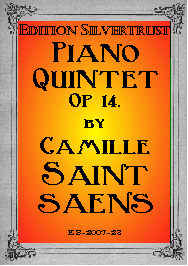Presents
Camille Saint-SaŽns
Piano Quintet in A Major, Op.14
 During
the third quarter of the 19 century, when the French only seemed
interested in opera, Camille Saint-SaŽns (1835-1921), almost
single-handedly, attempted to make the case for chamber music, which
so many of his countrymen continued to think of as something German.
Although
famous for his larger orchestral works and instrumental concertos, he devoted a
great deal of time and effort to writing chamber music. Not only
does he have two string quartets to his credit, but he also wrote
three works for piano trio, a serenade for piano, organ, violin and
viola ( or cello), a quintet for piano, two violins, viola and
cello, a Caprice on Danish & Russian Aires for piano, flute, oboe
and B flat clarinet and his Septet for piano, trumpet, two violins,
viola, cello and bass.
During
the third quarter of the 19 century, when the French only seemed
interested in opera, Camille Saint-SaŽns (1835-1921), almost
single-handedly, attempted to make the case for chamber music, which
so many of his countrymen continued to think of as something German.
Although
famous for his larger orchestral works and instrumental concertos, he devoted a
great deal of time and effort to writing chamber music. Not only
does he have two string quartets to his credit, but he also wrote
three works for piano trio, a serenade for piano, organ, violin and
viola ( or cello), a quintet for piano, two violins, viola and
cello, a Caprice on Danish & Russian Aires for piano, flute, oboe
and B flat clarinet and his Septet for piano, trumpet, two violins,
viola, cello and bass.
His Piano Quintet in A Major, composed in 1853, is his first major effort in the realm of chamber music and although it is undoubtedly a youthful work in spirit, from a compositional standpoint, it is not the work of a beginner. The well-respected critic and savant, Emile Baumann, writes of the Quintet as follows:
"It is singularly mature. Clearly the composer had already acquired such ease in writing that his technical skill never dulls the freshness of the work. From the beginning of the Allegro maestoso, it is evident that this a work inspired by nobility of form."
The work begins with a series of thundering chords in the piano with after which the strings softly answer. These chords are the first part of the dramatic main theme which is full of verve and energy and characterized by frequent turbulent stormy intervals. The second theme is more lyrical and relaxed. The broad main subject of the second movement, Andante, has a religious quality to it. From a technical standpoint, the writing shows a profoundly modern freedom of tonality. The Presto which follows begins like a fleet-footed elves dance but is repeatedly interrupted by stormy interludes reminiscent of those in the first movement. The finale, begins with a longish, quiet fugue which eventually leads to the beautiful and joyous main theme where our sound-bite begins.
This quintet is important not only from a historical standpoint--as Saint-SaŽns was only the second French composer to have attempted one--but also from a musical standpoint. It ought to be heard in concert and will also be enjoyed by amateurs. Our edition includes the ad-libitum Kontrabass part for the Presto.
Parts: $39.95